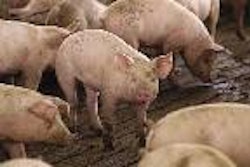Space and energy allowances for layers
A trial by scientists in Jordan and the University of Nebraska led to the conclusion that decreasing the number of birds per cage (and thus increasing cage space allowance per hen) had an overall positive effect on performance, but not on egg weight, hen weight, bone ash or maintenance energy intake. There were no significant effects of dietary energy levels.
The study was conducted to assess the effects of varying cage spaces on a commercial laying hen strain fed differing levels of dietary metabolisable energy (ME) for 15 weeks. There were four cage space allowances (342, 413, 516 and 690cm2/hen), and three levels of dietary ME (2800, 2850, and 2900 kcal ME/kg)
Egg production and egg mass were highest for hens housed at 690cm2/ hen, and the same birds used ME most efficiently for egg production.
— Jalal M.A. et al., 2006. Effect of bird cage space and dietary metabolizable energy level on production parameters in laying hens. Poultry Science, 85:306-311
Protozoan protects salmonella
Salmonella enterica bacteria may have found an ally in the form of a simple, single-celled protozoan. Microbiologist Maria Brandl, who works for the US Agricultural Research Service in Albany, California, is leading a team that is investigating this mysterious symbiotic relationship between the bacterium and the protozoan. It is hoped that their discoveries may lead to new, more powerful and more environmentally friendly ways to reduce the incidence of salmonella associated with poultry and other foods.
It seems that it all starts when a salmonella bacterium encounters the commonplace protozoan, Tetrahymena. The transparent and nearly invisible animal lives in water, including the water in soil, using its many filaments (known as cilia) to move through the water, while consuming any bacteria it encounters. Dr Brandl’s studies show that it cannot digest salmonella, but instead, it expels the bacterium back into the environment, alive, well and fully encased in a miniature pouch. Called a ‘food vacuole’, the pouch is made of an ultra-thin, flexible membrane that, Dr Brandl’s findings suggest, may afford important protection to salmonella. There may be as many as 50 Salmonella cells in each vacuole, possibly affording the innermost individuals protection against water, sanitisers and ultraviolet light.
If the protozoan encounters Listeria monocytogenes, however, that bacterium is digested, disabled and destroyed.
Dr Brandl and her colleagues are investigating the reasons for these different reactions by the protozoan because it is likely to have an effect on salmonella’s later survival and how it responds to our efforts to kill it for the sake of food safety.
— ‘Agricultural Research’ magazine, published by the USDA Agricultural Research Service
Fast-growing turkeys less able to cope with stress
The difference in disease resistance between lines suggests that selection for fast growth of turkeys may affect the stress response, resulting in increased chronic bacterial disease such as turkey osteomyelitis complex (TOC).
Scientists at the universities of Arkansas and Ohio state used two stress models to induce colibacillosis and turkey osteomyelitis complex in three turkey lines (a slow growing, egg line: a line selected for 16-week bodyweight, and a commercial line. Birds for each line were either subjected to transport stress and/or an E. coli challenge.
— Huff G. et al., 2006. Stress-induced colibacillosis and turkey osteomyelitis complex in turkeys selected for increased body weight. Poultry Science, 85:266-272















